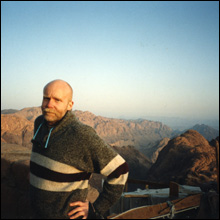 My lovable, impossible friend of more than 30 years, the artist Ralph Hamilton, died on February 19, of complications from diabetes. He was only 59. It’s a very sad loss. He was one of Boston’s most original and searching painters and had been doing some of his most ambitious and moving work.
My lovable, impossible friend of more than 30 years, the artist Ralph Hamilton, died on February 19, of complications from diabetes. He was only 59. It’s a very sad loss. He was one of Boston’s most original and searching painters and had been doing some of his most ambitious and moving work.
He was a local guy. He grew up in Newton Upper Falls and lived in Somerville. His degree was from the Massachusetts College of Art. His studio was at the Boston Center for the Arts, where he served at least one term as artist representative to the board of trustees, fighting on behalf of the other resident artists. He refused to teach but was a generous mentor to numerous fellow artists. His paintings are in the collections of Boston’s Museum of Fine Arts, the Addison Gallery, the Rose Art Museum, and the Metropolitan Museum of Art. He received major awards from the Pollack-Krasner and Ingram Merrill Foundations.

Part Anglo-Scottish and part French-Canadian, he was very quiet, moody, but had a dark sense of humor — his irreverence amused his friends and horrified his acquaintances. He hated the sun, loved stormy weather; his favorite color was gray. That dark spirit was reflected in the images he painted. Catastrophes — burning buildings, crashing vehicles, hurricanes, murder victims, executions — are among his central subjects. Also — and odd for someone with no interest whatsoever in athletics — sports. He made baseball, basketball, and soccer players (players he may never have heard of but who are instantly recognizable) look like dancers. Yet his sports figures are also battered: a boxer with his face smashed in, a high jumper leaping over the bar, a skater in a deep backbend, Mickey Mantle swinging a bat, Roger Clemens throwing a ball are his contemporary equivalents of Renaissance crucifixions. His paintings are unflinching, and they’re mysteriously beautiful.
He also painted remarkable portraits: nearly 200 of them (two of them are at the Met), most the same size and shape (30 inches square). Intense close-ups of personal friends and international celebrities: movie and media stars (Michael Caine, Michael York, Claire Bloom, Bea Arthur, Jean Stapleton, Jane Alexander, Terry Gross, Jack “Jimmy Olsen” Larson); artists (Grace Hartigan, Michael Mazur, Fay Chandler, Elsa Dorfman); poets (Seamus Heaney, James Merrill, Richard Howard, Elizabeth Bishop); many musicians (Pierre Boulez, Klaus Tennstedt, Seiji Ozawa, Elliott Carter, Virgil Thomson, John Harbison, Phyllis Curtin, Sarah Caldwell, Craig Smith, Benjamin Zander, Jane Struss, the legendary pianist Annie Fischer — in 1987, Symphony Hall hosted a show of these); even critics (Richard Dyer, Christine Temin, Ellen Pfeiffer). And dancers (Violette Verdy, Suzanne Farrell, Mark Morris). He had recently completed portraits of all but three of the Mark Morris dancers and was about to paint Baryshnikov and the Nicholas Brothers. His life-size, six-foot-high diptych of Suzanne Farrell and George Balanchine in the pas de deux from Balanchine’s Don Quixote is the most ravishingly poignant dance painting I’ve ever seen.
He was an avid reader, especially of Roman history, and poetry. (John Donne was a distant ancestor.) Some of his early paintings included words (“AWAY,” “GET WELL”), but he had little patience with words (or any art) that didn’t speak to him. Six of his Fourteen People, a series of life-size standing figures, are poets (among them Robert Pinsky, Frank Bidart, Gail Mazur, Joyce Peseroff, and Margo Lockwood). He did the covers for poetry books (including my own three), the Elizabeth Bishop bibliography, and a number of issues of Ploughshares. His eloquent portrait of Ella Fitzgerald was on the cover of Parnassus.
In 1985, David Bonetti, now the art critic for the St. Louis Post-Dispatch, wrote in these pages:
At the end of each century Boston has had a portrait painter of great interpretive gifts — Copley in the 18th, Sargent in the 19th, and now, I’d argue, Hamilton in the 20th. . . . The subjects of Copley and Sargent were the aristocracy of their times — merchants and their wives. Hamilton’s subjects are fellow artists and Intellectuals, a reflection of the change in values our society has undergone. Like his predecessors, though, he is creating one of those invaluable records that tell what a historical period was about.
These portraits certainly aren’t conventional. Most of them are based on his selection of one of the 20 or 30 bad snapshots he insisted on taking himself. (His other paintings are based mainly on published photographs.) One portrait is so close up, it looks more like a landscape than a face. When his subject saw the finished painting, she asked, “Where’s my hair?” Bea Arthur seemed delighted to have her portrait done until Ralph practically stuck his camera up against her nose to photograph her. “What the hell is this,” she bellowed, “an ad for facial hair?” He got only four photos before she stormed away, but one of them worked. He always said that these faces were in “conversational distance.” The painting was finished when the faces looked as if they were speaking to him.